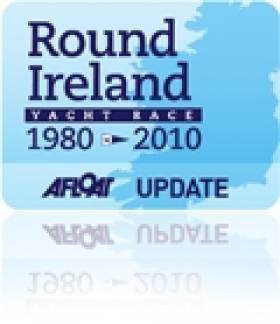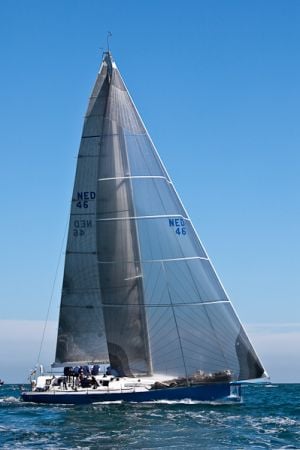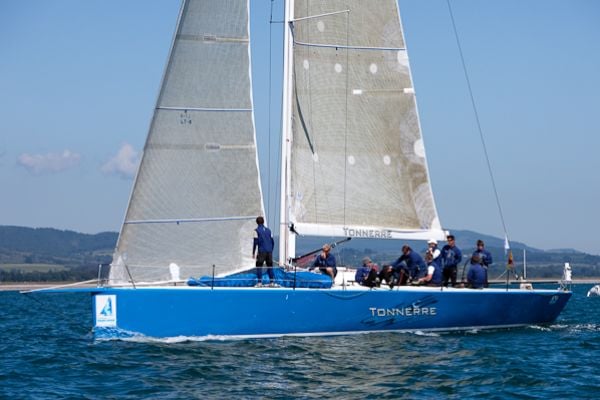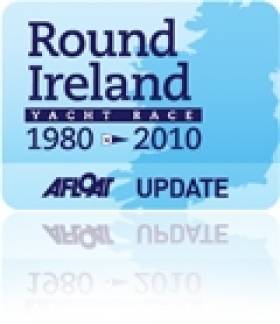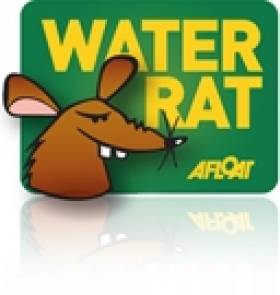As the leaders of the Conway Media Round Ireland Yacht Race enter the northern end of the Irish Sea, today will be all about current affairs, so be prepared to watch the teams' fates ebb and flow with the vagaries of Northern Irish tides. Tonnerre de Breskens and Spirit of Rosslare Europort are currently being hurried around the north-east corner by the end of a flood tide. However, Larne saw high water come and go at 08.11 this morning. That means that the leaders and those in their wake (Inis Mor and Daft.com) have maybe an hour of slack water before things turn against them and they end up jogging on a nautical treadmill. Adding to the impending misery, those east of Malin Head are in light airs, whereas those off the Donegal coast and even further back have stronger following winds whisking them up the rankings in handicap terms and helping them battle the tide. Tonnerre and Rosslare are past Rathlin, but not out of the woods yet.
Low Water at Larne is at 1418hrs, and how much the fleet will compress before then could well define how the results pan out when the finishers hit Wicklow.
One curiosity now will be who gets line honours.
Favourite before the race was the Open 60 Spirit of Rosslare Europort, the one boat in the fleet with the potential for greatest speed. However they've failed to make gains when the conditions were in their favour, and now face upwind conditions, or a fetch at best, down the Irish Sea. Open 60s are built for downwind sailing, and this will do them no favours.
They're duelling with the Dutchmen on Tonnerre de Breskens, who have sailed a near impeccable race so far, in line with their winning form on the RORC circuit, and led the IRC rankings at the last mark. From the Spirit of Rosslare Europort blog earlier this morning: "Passed Rathlin Island and chasing Tonnerre de Breskens 3 hard. We are set for a great duel down the Irish sea. We are sailing with 3.4knts of favourable tide but this is due to change at about 09.30 this morning as the tide turns foul.
"While we are on a IMOCA 60 - We have to take our hats off to the Guys on “Tonnerre de Breskens 3” - They are sailing that Ker 46 to her max."
Further back, Inis Mor is the main challenger for the overall title, with Visit Malta Puma pushing hard and the pair of them battling with the youngsters on Pride of Wicklow who have put in a valiant debut performance in a race that has thrown up ideal conditions for an opening foray into offshore sailing.
Psipsina continues to hold onto her double-handed lead, and could do some further damage to Daft.com's lead on the water around the top. Daft.com have been struggling with their on-board alternator, meaning that their on-board electronics have been used sparingly. This may have made things difficult for blind sailor Mark Pollock, reliant on a power-hungry audio nav system to help him steer the boat while Mick Liddy sleeps. (UPDATE: Mark Pollock just tweeted to say that their backup autohelm cut out during a gybe, and they report a suspected cracked spreader. Kite is down and they are assessing what to do)
Boats can now call in race reports from the water direct to our webmaster's voicemail for use as podcasts, just dial 08652570320 and leave your report after the beep, and we'll get it up online as soon as possible.
Have your say on the racing in our forum thread HERE.
The race tracker is HERE, and the official site is HERE.
More on the Round Ireland Yacht Race:
Round Ireland Yacht Race 2010 Review
Round Ireland Yacht Race, Ireland's top offshore fixture
A Round up of 80 stories on the 2010 Round Ireland Yacht Race



























